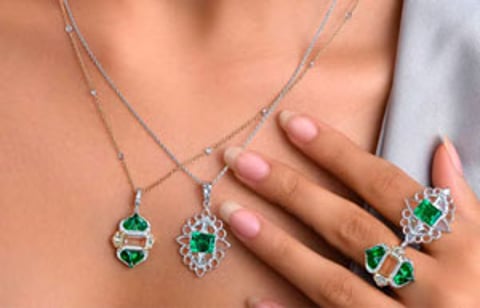

The unique flat surface and vintage charm of portraitcut diamonds are capturing the attention of jewellery enthusiasts and collectors across the globe. Priyanka Talreja Garegrat explores how this classic form of diamond-cutting has evolved into a style that signifies understated luxury
The portrait-cut diamond is crafted to create a unique window-like effect, resembling a slender pane of perfectly transparent glass. It is one of the oldest forms of diamond-cutting, believed to have originated in India during the 16th and 17th centuries. According to legend, the Mughal Emperor Shah Jahan was fond of portrait-cut diamonds and used them to protect and enhance the miniature hand-painted portraits in his jewels. This practice of placing portraits beneath the gems to enhance their appearance and protect them gave birth to the name "portrait cut.
This trend found its way to Europe in the 19th century, when both men and women started wearing hand-painted miniature portraits of their lover's eyes on a ring or locket, which would then be covered with a portrait-cut diamond. This way, the lovers felt connected to each other, even when physically apart. Unlike typical natural diamonds that exhibit brilliance, portrait-cut diamonds are meticulously crafted and polished to a level surface that resembles glass. Achieving the ultra-thin, clean diamond cut required for portrait-cut diamonds necessitates top-quality rough stones and expert precision cutters.
The Portrait-Cut Look: Like Water
Floating on the Skin
Today, the portrait-cut diamond
represents an understated and crisply
tailored style of jewellery. This look is
for women who prefer the ‘barely there’
glamour. Because these stones are flat,
designers today prefer to use very little
metal around them, making them look
like they are floating on the skin.
Portrait-cut diamonds are also versatile
and can be fashioned into a wide variety
of shapes, ranging from classic round and
oval cuts to more unconventional shapes
such as hexagons, triangles and kites. This
flexibility allows designers to create unique
and striking pieces that can be tailored
to meet individual preferences. While
the antique portrait cuts had a brown
cast, the contemporary ones are found in
higher colours, such as D, E, and F.


Portrait-cut Allows for Light-Weight
Diamond Jewellery
As jewellery pieces, portrait cuts also
tend to be lightweight in comparison
to other diamond cuts as they require
less metal in their setting, compared to
traditional faceted diamonds. This is
because portrait-cut diamonds are flat
and have a lower profile, which means
that they do not require as much metal to
hold them securely in place.
With less metal used in the setting, the
diamond is allowed to shine and sparkle
more prominently, making it a standout
feature of the piece. Additionally, less
metal means that the overall weight
of the jewellery is reduced, making it
more comfortable, affordable, and less
cumbersome to wear.
In conclusion, the portrait cut diamond
offers unparalleled understated luxury
with its delicate, yet precise, design. Its
ultra-thin, glass-like appearance and
flawless cut make it a perfect gem that
has been billions of years in the making.
While some may not immediately
recognize it as a diamond, this only adds
to its allure, making it a personal treasure
to be cherished by the wearer. The
portrait-cut diamond truly embodies the
essence of pure magic.
Follow DiamondWorld on Instagram: @diamondworldnet
Follow DiamondWorld on Twitter: @diamondworldnet
Follow DiamondWorld on Facebook: @diamondworldnet
